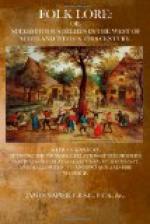The Ash had wonderful influence. The old Christmas log was of ash wood, and the use of it at this time was helpful to the future prosperity of the family. Venomous animals, it was said, would not take shelter under its branches. A carriage with its axles made of ash wood was believed to go faster than a carriage with its axles made of any other wood; and tools with handles made of this wood were supposed to enable a man to do more work than he could do with tools whose handles were not of ash. Hence the reason that ash wood is generally used for tool handles. It was upon ash branches that witches were enabled to ride through the air; and those who ate on St. John’s eve the red buds of the tree, were rendered invulnerable to witch influence.
The Hazel was dedicated to the god Thor, and, in the Roman Catholic Church, was esteemed a plant of great virtue for the cure of fevers. When used as a divining rod, the rod, if it were cut on St. John’s Day or Good Friday, would be certain to be a successful instrument of divination. A hazel rod was a badge of authority, and it was probably this notion which caused it to be made use of by school masters. Among the Romans, a hazel rod was also a symbol of authority.
The Willow, as might be expected, had many superstitious notions connected with it, since, according to the authorized version of the English Bible, the Israelites are said to have hung their harps on willow trees. The weeping willow is said to have, ever since the time of the Jews’ captivity in Babylon, drooped its branches, in sympathy with this circumstance. The common willow was held to be under the protection of the devil, and it was said that, if any were to cast a knot upon a young willow, and sit under it, and thereupon renounce his or her baptism, the devil would confer upon them supernatural power.
The Elder, or Bourtree had wonderful influence as a protection against evil. Wherever it grew, witches were powerless. In this country, gardens were protected by having elder trees planted at the entrance, and sometimes hedges of this plant were trained round the garden. There are very few old gardens in country places in which are not still seen remains of the protecting elder tree. In my boyhood, I remember that my brothers, sisters, and myself were warned against breaking a twig or branch from the elder hedge which surrounded my grandfather’s garden. We were told at the time, as a reason for this prohibition, that it was poisonous; but we discovered afterwards that there was another reason, viz., that it was unlucky to break off even a small twig from a bourtree bush. In some parts of the Continent this superstitious feeling is so strong that, before pruning it, the gardener says—“Elder, elder, may I cut thy branches?” If no response be heard, it is considered that assent has been given, and then, after spitting three times, the pruner begins




